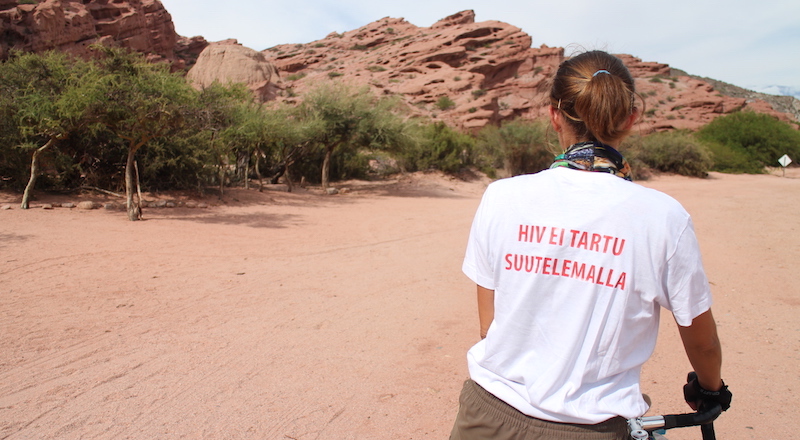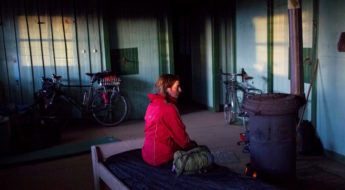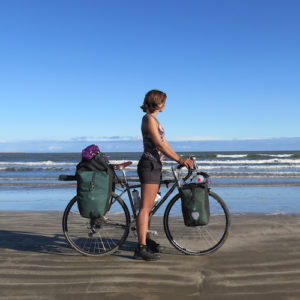10 LESSONS ON SEXUALLY TRANSMITTED DISEASES WHEN TRAVELING

First of all, this is not a date add and I DON’T accept random friend requests on Facebook, so spare your time. Secondly, I’M NOT looking for company, and even less so on the internet. Thirdly, I DON’T travel alone because I don’t have a man (this is a misconception I’ve encountered numerous times), but because I ENJOY traveling alone. Having said this, here’s something I want to remind you about: the risks of sexually transmitted diseases when traveling (or back home).
If you’re single and not highly conservative, chances are that at some point on a longer (or short) trip you’ll end up having sexual relations with someone. Why? Because you continuously meet new people with whom you share short but intense encounters, and although 99.9% of these moments don’t necessarily lead anywhere near sex, a tiny 0.01% may (after all, we are sexual beings). However, before you let go of all your sexual inhibitions on the road, here’s a list of 10 things to keep in mind.
Disclaimer: this post refers to no recent encounters or happenings.
10 Life lessons about STDs
Since the age of 18, I’ve been in close contact with sexually transmitted diseases, or more accurately, with hiv. It’s been part of my whole adult life, and I’ve also been working as a volunteer for hiv positive people for more than ten years now. I’m not hiv positive myself, but I have no need to hide the fact that I have had a few other STDs/STIs during my life (and I’ve never hidden the fact from anyone I’ve had intimate relations with). I tell this as a person who tends to be very careful regarding protection, who has quite an average sexual life (I suppose), yet who has still managed to catch some unpleasant infections in her past.
It really takes just one accident to catch an STD. Not all of them are highly contagious, but sometimes even just a moment’s contact of bodily fluids can be enough to spread a disease. Yes, even this. And what many people don’t realize is that even that saint-looking (and acting) girlfriend of theirs or that man with beautiful blue eyes (sorry for the stereotype) could be the lucky owner of one or two STDs. The messed up thing is that people don’t talk about this, because it’s not exactly the coolest topic to bring up in the heat of the night (or even before or after). Yet, here’s my attempt to change this and make you realize that STDs are just a normal part of human life (although not the greatest part for sure!). Please keep in mind that I’m not a doctor.
1st lesson: never trust anyone
I don’t want you to get paranoid. As I just said, STDs are a part of human life and, according to statistics, most sexually active adults have had at least one STD during their lives. It’s not a thing people should feel ashamed or guilty about, and it’s definitely not a thing to fall silent about. Yet, many people do. Afraid of losing the love of their lives or just the opportunity to get laid, surprisingly many people a) don’t tell about having an STD, b) don’t know about having an STD or c) lie about not having an STD.
So, words won’t protect you but a condom will. Take it from someone who only once in her life decided to trust someone she had been with for over a month and who supposedly had been tested “a while ago without any unprotected sexual relations since”. After me getting symptoms it turned out that “the while” was actually three years and that the “no unprotected sexual relations since” was actually “not so many unprotected sexual relations since”. Great! Lesson learnt: be very wary of whom you trust. (Btw. many hiv positives I know have actually gotten the virus from husbands/boyfriends or wives/girlfriends who they’ve trusted.)
2nd lesson: mistakes can and do happen
As a child of the 80s, I represent the generation born at the dawn of the first hiv epidemic. Therefore also at the dawn of the most intense sexual education in history. Due to this and the fact of having had hiv close to me, I’ve always been extra careful when it comes to protection. I’ve tried to emphasize the use of condoms to all my friends who have occasional, unprotected sex with strangers. I’ve accompanied them to STD tests. I’ve given sex ed in middle schools, distributed condoms instead of candies at the high-school graduation party (where Finns normally climb on trucks and tour the neighborhood throwing candy at passers by), made educational videos on hiv, written numerous articles about it. And still, after all this, I’ve managed to fail with protection once (as mentioned above).
No matter how careful you usually are, there can be that one time that you act against your better judgement for one reason or another. It’s also not uncommon for a condom to break, even if used properly, so keep in mind that if it has happened to you, it has probably happened to your sexual partner(s) as well. Therefore, in case of protection failing, do get tested for STDs (even if you’re symptomless).
3rd lesson: STDs spread through all unprotected sexual contact
In many countries (especially in religious ones), there is no sexual education in schools. For example, in Latin America the basis for sexual education is mostly television with its scandal-loving talk shows and Mexican telenovelas (soup operas). So, needless to say, the “education” is not just slightly inaccurate or exaggerated but usually downright wrong from every little detail all the way to the big picture. (Only a couple of weeks ago I saw an Argentinian talk show where the host said that HPV, the human papilloma virus, was a “disease which makes you infertile, makes you die of cancer and stops you from ever having sex again”. What an exceptionally great way to scare people with a disease which more than 70% of the adult population in the US have had at least once during their lives!)
Due to the lack of quality sex ed, many people around the world a) are scared of STDs without even knowing what they are and b) have no idea how they spread. So, here’s the deal: sexually transmitted diseases spread through all contact of bodily fluids (except saliva to saliva), from sperm to pre-ejaculate fluids to blood (this includes the tiny blood vessels of the anus). Therefore, if you wish to avoid STDs, you need to avoid ALL contact of bodily fluids – including oral sex, anal sex, vaginal sex and all pre-penetrational activities where precum gets in contact with any of the other before mentioned fluids.
4th lesson: most people have or have had STDs
According to the statistics, more than half of all sexually active adults have or have had an STD/STI during their lives. In addition to this there are those who haven’t either ever or recently been tested and who therefore do not know about their status. Yet, even if you have no symptoms whatsoever, you can have an STD if you’ve ever come in contact with anyone through any of the ways described above.
The most common STDs vary according to geographical location. In Latin America, syphilis is the most common bacterial infection after chlamydia. In Europe and in the USA, the most common one is chlamydia, and of viral infections HPV. After that come gonorrhea and genital herpes.
The only incurable ones are HPV, HSV and hiv, of which the latter is the most uncommon. However, even though they cannot be cured, all STDs can and should be treated to avoid further complications (and possible new infections).
5th lesson: early symptoms of STDs
Typical STD symptoms include fever, complications (itching, bleeding etc.) when urinating, headache, swollen glands, altered discharge, blisters, sores etc., which usually show up 1-4 weeks after a fresh infection. However, not all STDs develop symptoms, and this is what often causes for people not getting tested. No one wants to live with continuous urinary tract infection symptoms, but why on earth would you get tested if you’re healthy, right? WRONG!
Whatever it is you feel down below that’s different to normal, get tested – NOW. Even if you feel nothing strange at all but you’ve had unprotected sex (or if a condom has broken or stayed inside of you), get tested – NOW. Many STDs will get more serious and complicated as time passes, and some of them (like chlamydia) may even cause infertility if left untreated. So, take care of yourself! Having said this, hiv will only show in test results after three months, so you’ll need to get tested twice for certainty on all diseases.
6th lesson: get yourself a medical insurance
When traveling, I’m sure many would agree that there’s nothing worse than being sick on the road. Whether it’s food poisoning, diarrhea or high fever what you have, not being well is not fun. And suspecting a sexually transmitted disease is definitely no exception (especially when traveling by bicycle!).
In many countries in Europe and Latin America (I’m not sure about Asia, Africa or North America), you can get tested for STDs for free in public hospitals. The good news is that it’s free. The bad news that the queues can often be days or weeks long (because the tests are done in the same laboratory as all other blood and urine tests) and the hospital might be short on the equipment needed for conducting the tests and producing reliable results. So, having a travel insurance which covers medical costs and laboratory tests will not only save you a lot of hassle, but will also save you a lot of money should you be diagnosed with an STD.
7th lesson: getting tested for STDs abroad can be pure hell
In some countries all health care is free for everyone, even for foreigners (in Finland you have to be a Finnish citizen in order to be treated for free). Although this is great, the fact is you might have to go through five medical professionals and wait for two weeks before getting tested for STDs. It kind of makes you lose interest into getting tested altogether, doesn’t it? (Which obviously leads to undetected infections and more complications.).
Here’s a “random example” for getting tested for STDs in a foreign country
Day 1: Hospital at 10am. You’re told you need a doctor’s referral in order to proceed. You can get this either at the same hospital in more than a week or at any local health care center in a day.
Day 2: Health care center at 8am. You’re told the doctor will only be the following day at 8am.
Day 3: Health care center at 8am. The doctor shows up at 10am. When you tell him you want to get tested for STDs, he insists you should have a good reason for the request. Apparently, having had unprotected sex is not enough (should’t all doctors appreciate the will of getting tested?). In the end, he unwillingly hands out a referral.
On the same day, you cycle in pouring rain to the hospital. There, you need to take a numbered ticket which leads to the cue to get another numbered ticket for the laboratory. However, all numbered tickets have been handed out for the day.
Day 4: Hospital at 7am. You get the numbered ticket, wait for two hours and get another numbered ticket (the one which will grant you entry to the cue of the laboratory).
Day 5: Hospital at 7am. You wait for three hours in a cue, before finally getting to the help desk of the lab. There, you’re given dates for executing the exams. There are no available times for the same day, so you and the person you’re trying to get tested with are scheduled for two different days.
You wait for a week.
Day 13: Hospital at 7am. The due date of your exam. You enter the lab after waiting for an hour and what do you find out? The doctor has only written you a referral for hiv, no other STDs. This means that the referral is basically useless (because hiv won’t show so soon anyways).
Day 15: Hospital at 7am. The due date of other person’s exam. After waiting for an hour, he/she is tested for hiv. The results will be ready in two weeks and by then, both of you will have left the country. However, the results are only handed out personally, so you have to send a friend of yours to fetch them.
Day 17: You’re feeling physically very uncomfortable (note that it’s been more than two weeks of complications by now). You call a friend of a friend and ask him/her if she can recommend a private doctor to you. He/she does, and takes you to see a person who does night shifts at another public hospital. You tell the him/her you’ve had unprotected sex and he/she gives you on STDs. After this, he/she executes a routine examination on you, yet due to the lack of needed equipment, cannot take any tests for STDs. Nevertheless, he/she decides to give you medication against gonorrhea. Just in case.
You wait for two weeks.
Day 31: You reach a bigger city and go to a private clinic to have an examination. As you’re traveling, you decide not to wait one week for the results, but ask if you can call for them. The answer is yes.
You wait for a week.
Day 38: You call for the results and you’re told you need to get them in person. They cannot be handed to you over the phone. You tell the person at the other end of the phone you’ve paid a huge amount of money for the tests, and finally a scanned version of the results is passed on to you by email. You don’t understand any of it, and neither do any of your friends. You decide to leave it be for now (because there’s nothing more you can do and because you know you’ll have a chance to get tested soon).
8th lesson: getting tested for STDs back home can be bliss
If you’re heading home soon from your travels (notice the word SOON, which does not mean half a year later), sometimes the best thing you can do to save you a lot of trouble, time and money is to wait and get tested back home. If the symptoms are very bad, another extreme option is to abort your trip altogether, return home and get tested.
…continuation of the above mentioned example
Two months after all the useless tests abroad, you return home. You still don’t feel great, so you decide to go and have yourself checked as soon as possible. Only a day after your arrival, you walk into the Policlinic for Sexually Transmitted Diseases, take a cueing number and fill in a form. Half an hour later you are fully examined and have every possible test taken (for free). You’re told that in case of a positive result, you’ll receive a phone within two weeks. The following week you do indeed receive a phone call, you’re prescribed medication (which you get for free from the Policlinic) and within three days all the symptoms are gone. Moreover, you’re given a new appointment for a follow-up.
9th lesson: tell your sex partner(s) about your STDs (but don’t expect praise for doing so)
After discovering an infection, there are two important things to do: (1) use protection at all times with possible future acquaintances and (2) make sure to inform the person you have gotten the STD from about your detected infection. However, it’s everyone’s own responsibility to protect themselves, so if you haven’t, don’t blame anyone else for it. The same goes for telling about STDs: if you use protection, there’s no need to tell about an STD unless you want to and unless you’re doing things where the risk of protection failing is bigger than usual.
Now, telling the person you’ve gotten an STD from about his/her infection is not always pleasant experience. In the 1st lesson I mention having trusted someone I shouldn’t have and getting an STD from him (see also example in 7th lesson). What I did as soon as I found out about my infection, was inform him (let’s call him X) about it, thinking he’d be relieved to know. Yet his reply? “I wish I had never met you”. Say what?! I still wonder how someone who has lied to you about having been recently tested treat you like you were the bad guy here. And give you the blame for possibly having passed the STD onto a third person…(In the meanwhile, X had had unprotected sex with his new girlfriend).
10th lesson: test results can lie
Sometimes, test result can be inaccurate or wrong. In the case of X, he was tested clean in his home country. In praxis, this means three things:
a) either X is lying and ignoring his infection
b) the foreign health care has tested a false negative
c) the Finnish health care has tested a false positive
Whatever the reason may be, it’s important to get tested and treated just in case, even if there’s just a slight possibility of false test results. Cycling (or any form of traveling or being) is definitely not fun with an STD and what’s even less fun is when you know something’s wrong, but you have no idea what it is. So, don’t get paranoid, but take care of yourself! Prevention is great, but if mistakes happen, go and get tested as soon as possible.
How to avoid STDs?
- Refrain from sex
- Avoid all contact of bodily fluids (except for saliva)
- Always use a condom (during oral and anal sex, petting and vaginal penetration)
You’re the one who needs to take care of yourself. It’s no one else’s responsibility.
If you suspect having an STD:
- Get tested immediately (hiv only shows 3 months after possible infection)
- If you have a health/travel insurance, go to a private hospital
- Use condoms to avoid further infections on you and your partner(s)
- If you’re prescribed a medicine, take in the whole course
- If nothing else helps, go home and get tested there
- Whatever you do, don’t ignore the symptoms!
















